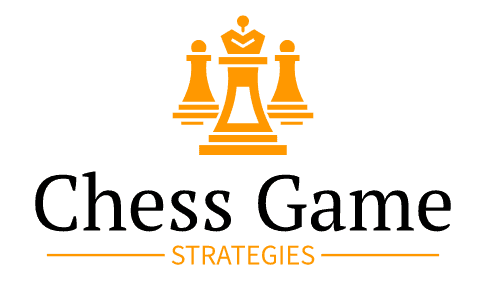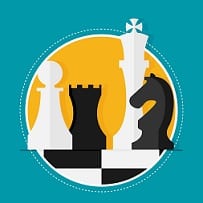
This collection of images includes the following Tactics (in order, from top, to the bottom of this page):
- Battery Attack
- Discovered Attack
- Discovered Check
- Fork Attack
- Pin Attack
- Skewer Attack
There are more Tactics, in Chess, than those. But, the other Chess Tactics need more explanation than can be given with a simple animated diagram – like you’ll find with the following collection of Chess Tactics images.
You can see all 15 Chess Tactics, in full, from our Chess Tactics Index.
Battery Attack
Battery Attacks involve either the Queen & Bishop, along the Diagonals; or, the Queen and Rook(s), along the straights (Ranks or Files).
The idea is to build-up power, just like a domestic/household battery, where the addition of more cells (Pieces, in this case), increases the strength of the Battery.
Battery – Queen & Bishop
This type of Battery can only happen along the Diagonals.
Often, it’s best to lead with the Bishop (because it’s more expendable).
But, as with all of these Tactics, you must allow the circumstances – the unique position on the Chessboard, to dictate proceedings.
You’ll see an example each type of Battery, in the four accompany Chess Tactics images.
Battery – Queen & Rook
This type of Battery Attack can occur either across a Rank or, as shown in the image (left), along a File.
It’s preferable to lead with the Rook. Though, again, your Queen can be at the head of the Battery.
Battery – Queen & 2x Rooks
A Queen and 2x Rooks is the most powerful Battery Attack you’re likely to see, in games of Chess.
Alexander Alekhine used to use this in his games, with the two Rooks leading the Queen, along a File, pointing at the enemy.
Since then, this Battery formation has become known as Alekhine’s Gun.
Battery – 2x Rooks
Probably the least formidable, but still can have a significant impact (depending on the circumstances on the Board).
The Rooks can form the Battery either along the Files, as in the diagram (left), or across a Rank.
Discovered Attack
Discovered Attack
With the Discovered Check, the uncovered, attacking unit attacks the enemy King.
Because it involves a Check, the opponent (Black, in this case) must rescue the King at ALL cost.
In the image (left) White’s Bishop performs the Discovered Check. Black must save the King, but will lose the Black Queen to White’s Knight.
Fork Attack
The Fork Attack sees one unit attack two enemy units in a single maneuver.
As you’ll see with the following Chess Tactics images you get two types of Fork – Relative & Absolute.
Fork Attack – Relative
The Relative Fork attack sees one unit attacking two or more enemy units in a single maneuver.
Relative Attacks don’t include attacking the enemy King. The attacked opponent must choose which unit to rescue – the other will most likely be captured.
Fork Attack – Absolute
Because this is Absolute, one of the attacked units, in the Absolute Fork, is the enemy King. The King MUST be rescued/made safe; the other Pawn/Piece is left to its own fate.
Pin Attack
The pattern for identifying potential Pin Attacks is when you see a less-valuable Pawn/Piece that’s in front of a more-valuable Piece.
Pin Attacks can be either Relative or Absolute.
Pin Attack – Relative
The Pin involves attacking a less-valuable Pawn/Piece, which is sitting in front of a more-valuable Piece.
Because it’s Relative, it means the two enemy units are any, but NOT the King.
Beware, as the Pinned unit (White’s Knight, in this case) can break the Pin by moving away, to leave the greater-value Piece to its fate (for Strategical reasons!).
Pin Attack – Absolute
When the Pin is Absolute, one of the enemy Pieces at risk is the King.
Once Pinned (Absolutely), the less-valuable Pawn/Piece CANNOT move out of danger. It must remain to protect its King. To move would be to place its King in Check, which would be illegal.
Here, Black’s Queen is absolutely Pinned against her King, by White’s Rook.
Skewer Attack
The pattern for identifying potential Skewer Attacks is when you see a more-valuable Piece that’s in front of a less-valuable Pawn/Piece.
Skewers can be either Relative or Absolute, as you’ll see from the following Chess Tactics images.
Skewer Attack – Relative
The Skewer involves attacking a more-valuable Piece, which is in front of a less-valuable Pawn or Piece.
The idea of the Skewer Attack is to force the more-valuable unit out of the way, so you can capture the less-valuable unit behind.
In this case (see image, left), White’s Bishop is after capturing Black’s Knight.
Skewer Attack – Absolute
The Absolute Skewer attacks the enemy King directly, which puts it in Check. This forces the King to step aside, so the less-valuable Pawn/Piece becomes accessible to capture.
In this image (left), White’s Queen Absolutely Skewers Black’s King. The King will have to move, to escape Check … White’s Queen will then be free to capture Black’s helpless Rook.












